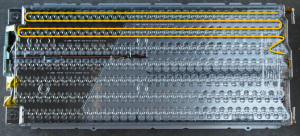Fiber Optic Testing Helps Ensure EV Battery Health and Safety
Approximately1.2 million electric vehiclesare currently on the road in the United States. However, while EV market share is growing, it still accounts for a modest fraction of vehicle sales in the United States.
EVs face unique design challenges in order to be competitive with gasoline-powered vehicles. The root of many of these challenges is in the EV battery pack. Drivers want similar vehicle range per charge when compared to a tank of gas, as well as the convenience they are used to with refilling a tank in just a few minutes. This means battery packs need to be able to store enough energy to go comparable distances without stopping and to get back on the road quickly once depleted.
Many EVs today use thousands of lithium ion cells to form the complete battery pack that powers a vehicle. Lithium ion batteries come with certain limits. They do not charge well at very low temperatures, and they can be dangerous if overheated, overcharged, charged too quickly or physically damaged.

锂离子电池的理解……和by extension their safety is continuously evolving. However, in a system that has thousands of cells packed in close proximity, a defective battery could cause thermal runaway and lead to a chain of violent cell failures. While rare, such an event is of concern in a passenger-filled vehicle that can sustain physical damage, especially one that uses a pack that is charged as quickly as possible.
High Definition Fiber Optic Sensingis a valuable tool for ensuring battery health and driver safety. Sensors are electrically passive, corrosion resistant and immune to EMI, allowing them to make measurements within a battery pack or an individual cell without risking a short circuit or picking up noise from electronics. The temperatures of all battery cells can be monitored during recharge or discharge to quickly look for damaged or faulty cells, which need to be replaced.

One possible future for EVs is detachable battery packs where a car pulls into a recharge station but instead of plugging in and charging its battery, the pack is removed and quickly replaced with a different fully charged pack, leaving the previous one to be charged and stored at the station. Packs would not belong to any individual driver. In this case, fiber could be placed within each pack and then while being recharged at the station, each battery pack could also be scanned to ensure the health of all cells in circulation. This application would grow in importance over time as the average age of battery packs in use rises. This application would allow batteries to charge at a safe rate in climate-controlled environments for an overall increase in battery life.